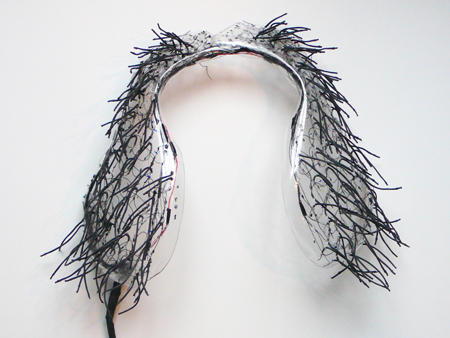Squamata
Squamata is a set of headphones that uses its skin of scales to indicate the atmosphere of the music played on them. These scales do not literally respond to every beat of a song but they slowly shift between appropriate states as the songs go by. It functions as a visualization of ones mood triggered by music rather than the actual song itself. The main focus of this project in my first master semester was technical prototyping and aesthetic communication. To my surprise the project got mentioned by a series of online blogs.

The natural world around us is full of signs, or at least we (humans) can find them everywhere. Over time we have learned to read our environment. From our perspective nature is full of information, displayed on the outsides of the subjects themselves. We can tell when fruits are ready to be eaten or whether to stay away from certain animals, merely by their appearance or 'skin'.
Human made objects are generally much poorer in the way they display information about their functioning. This information is often communicated through tiny details like indication lights. In cases we have learned to perceive 'undesigned' signs from these products it is usually not through their visual appearance but through other means. This project aims to create new products that do have informative and adaptive skins. How can products change their outsides along with their insides? Do we need to learn how to interpret this information as we have done in nature?
Context
Just like a recently lost loved one or a fresh new love have the power to completely change the way we perceive the world around us, listening to music can create an extremely strong personal atmosphere and has great influence on the listener's mood and thoughts. A world full of beautiful people or an entire universe conspiring against you, they can be just one click apart.
A train carriage is filled with dozens of different atmospheres. It is the personal control which makes personal music players such a huge success. This means control over space, time and interaction with others. It helps us walking a scary street alone at night, forgetting our sorrows or laughing at the sight of pigeons. Using a personal stereo allows us to make up stories, construct narratives with the things and people we see and the music we hear. It allows us to feel as if we were outside of reality.
Wearing a headset tells others that you're minding your own business and that they should too. These effects are so strong that it's even more accepted to stare at strangers as it gives you the excuse that you're actually thinking of something else. After the introduction of the Sony Walkman in the 1980's listening to personal music in public was considered rude and a sign of decline of intellectual culture. Since then listening to music privately has become widespread and socially more acceptable. It is now time to open a small peephole into our private atmospheres.

Prototyping
To create the required movement, nitinol shape memory alloy is used. When heated (or under high current), it straightens. The wire is cut in different sizes to support the different sizes of scales used. To create electrical connections pieces of kynar (which are thin and allow relatively high current) wire were used. Since soldering tin does not connect with nitinol, all connections in the prototype are created using small beads squeezing the wires together. The part of the nitinol that is on the outside of the headphones is insulated with shrinking socks.
Holes were punched in the plastic base for the prepared pieces of nitinol to go through. For each scale two memory wires are placed, one to push the scale up, one to pull it back down again. Nitinol wires are lead through these holes, and attached on the inside of the base. The scales of one of fifteen rows are connected in series with each other and with the row at the opposite side.
